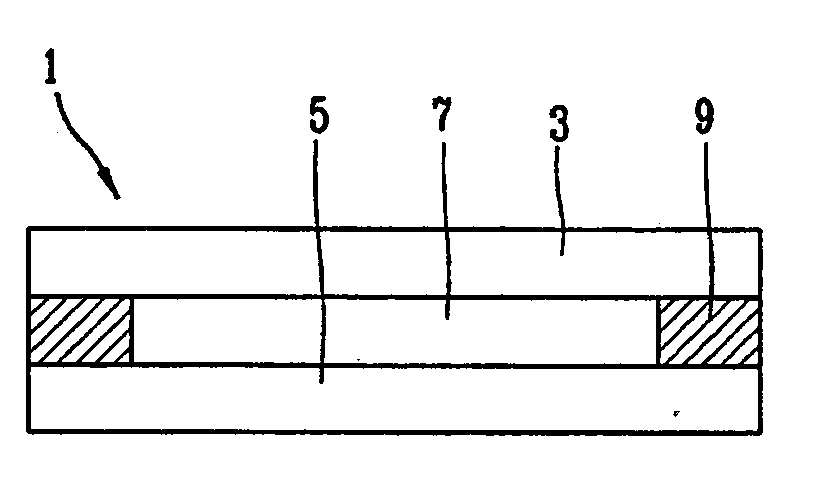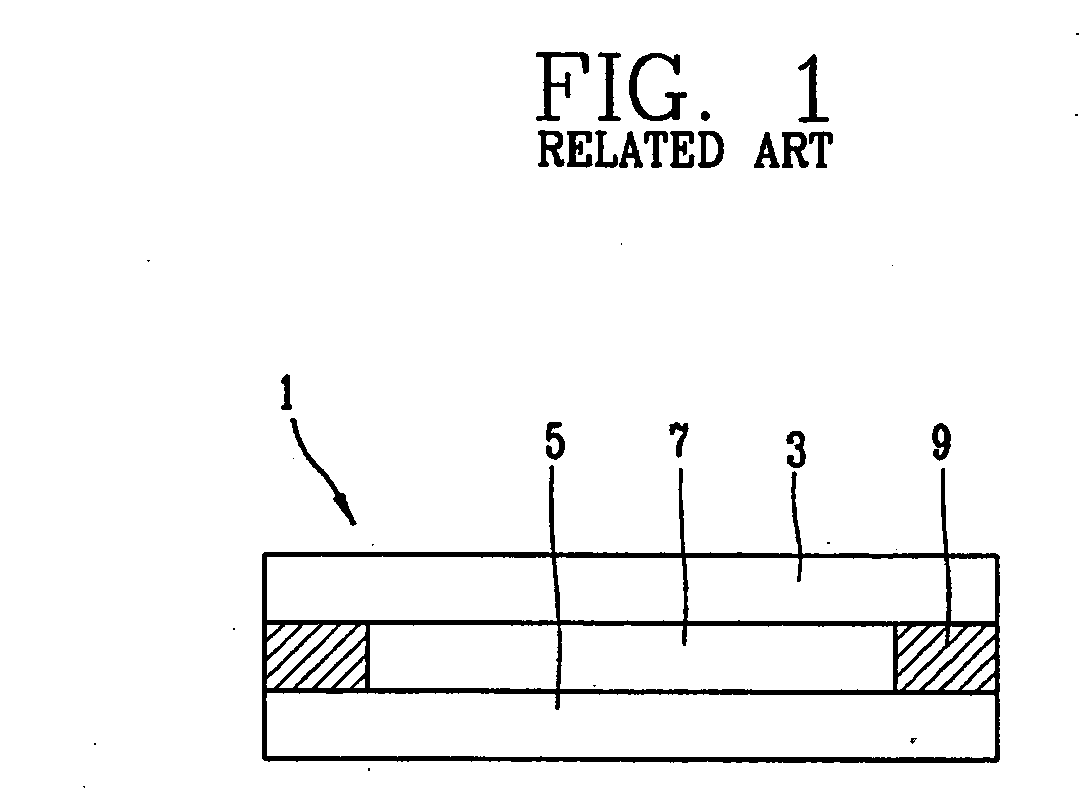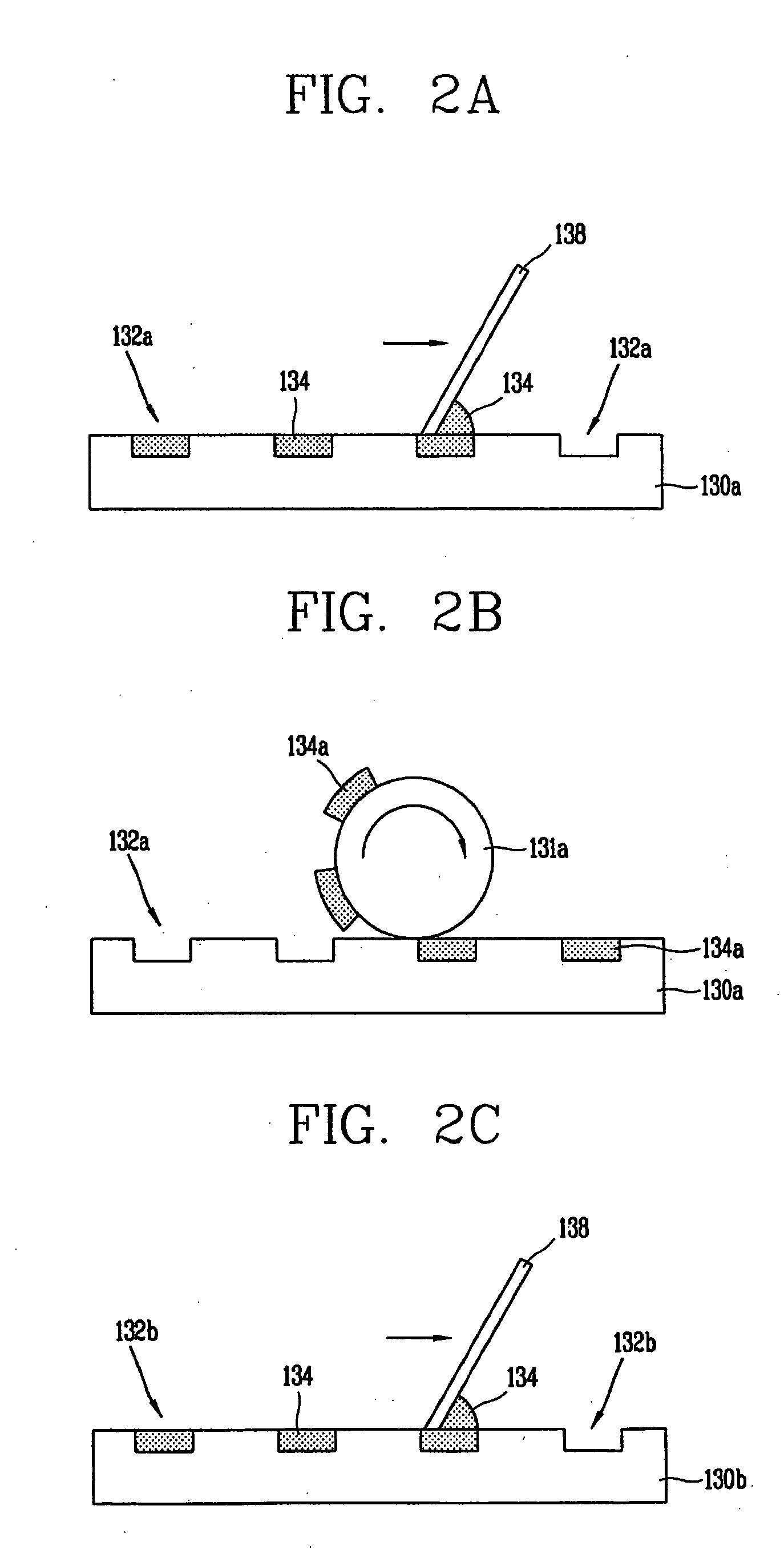Method for forming black matrix of liquid crystal display device
a liquid crystal display device and printing method technology, applied in the direction of lithography, rotary lithographic machines, instruments, etc., can solve the problems of reducing productivity, deepening of step differences, and addition of photolithographic processes, so as to simplify the required processes, improve productivity, and effectively shield light
- Summary
- Abstract
- Description
- Claims
- Application Information
AI Technical Summary
Benefits of technology
Problems solved by technology
Method used
Image
Examples
first embodiment
[0033]FIGS. 2A to 2F illustrates a method for forming black matrixes according to the present invention. First, as illustrated in FIG. 2A, a concave plate or first cliché130a is provided with a plurality of grooves 132a formed at specific positions. The plurality of grooves are then filled with a black matrix resin 134. The plurality of grooves 132a are formed in the first cliché using a typical photolithographic method. Each of the plurality of grooves 132a are filled with the resin BM 134 by depositing the resin on the first cliché130a and thereafter pushing a blade 138, which is in contact with the surface, over the first cliché130a. As a result, the resin is filled in the plurality of grooves 132a according to the movement of the blade 138, while any resin remaining on the surface of the first cliché130a is eliminated.
[0034] Accordingly the thickness of the BM to be form is determined by the depth of the first groove 132a. When the depth of the first groove 132a is shallow, a re...
second embodiment
[0043] According to the present invention, the black matrixes are printed on the substrate by forming grooves on the surface of the printing roller without using the cliché, and then filling the resin BM in the grooves, as illustrated in FIGS. 3A-3C.
[0044] As illustrated in FIG. 3A, a printing roll 231 having a plurality of grooves 232 thereon is prepared. The printing roll 231 is rotated such that a predetermined region of the roller is submerged in a container 220. The container 220 is filled with a black matrix resin 234. As the roller is rotated, the surface of the printing roller 231 is pushed with a blade 238 to remove the resin 234 from the surface, thereby filling the grooves 232 with the resin 234. Thus, after preparing first and second printing rollers 231a and 231b in which first resin BM patterns 234a and second resin BM patterns 234b are filled therein, respectively, as illustrated in FIG. 3C, the first printing roll 231a is rotated across the surface of a substrate 240...
third embodiment
[0045] According to the present invention, the black matrixes are printed on the substrate using a printing roller having convex patterns corresponding the shapes of the black matrixes to be formed as illustrated in FIGS. 4A-4C.
[0046] As illustrated in FIG. 4A, a printing roller 331 having a plurality of convex patterns 332 corresponding to the shape of the black matrixes to be formed is provided, and a black matrix resin is deposited on the surface of the convex patterns to form resin BM patterns 334. The resin is deposed on the convex patterns by rotating the printin roller 331 such that is comes into contact with a resin supply roller 360. As the resin supply roller 360 engages with the printing roll 331, the resin 334 applied over the surface of the resin supply roller 360 by a resin supplier 335 is transferred onto the convex patterns 332 of the printing roll 331.
[0047] As illustrated in FIG. 4B, a first printing roll 331a having first convex patterns 332a on which first resin...
PUM
| Property | Measurement | Unit |
|---|---|---|
| shape | aaaaa | aaaaa |
| sizes | aaaaa | aaaaa |
| color | aaaaa | aaaaa |
Abstract
Description
Claims
Application Information
 Login to View More
Login to View More - R&D
- Intellectual Property
- Life Sciences
- Materials
- Tech Scout
- Unparalleled Data Quality
- Higher Quality Content
- 60% Fewer Hallucinations
Browse by: Latest US Patents, China's latest patents, Technical Efficacy Thesaurus, Application Domain, Technology Topic, Popular Technical Reports.
© 2025 PatSnap. All rights reserved.Legal|Privacy policy|Modern Slavery Act Transparency Statement|Sitemap|About US| Contact US: help@patsnap.com



